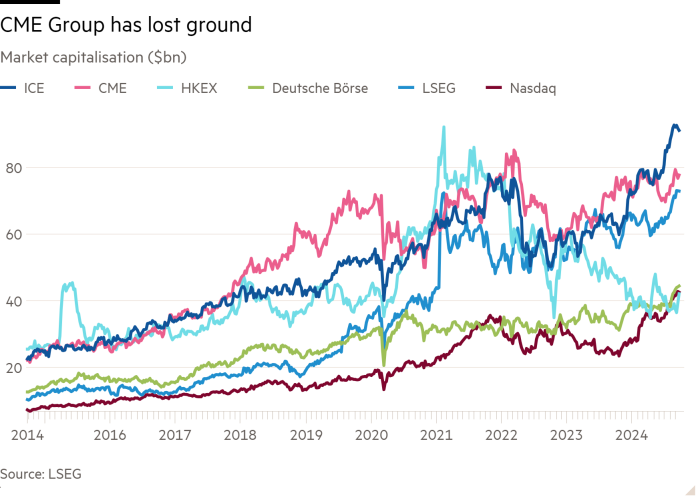Rivals are not the only reason for CME’s lost lustre

Unlock the Editor’s Digest for free
Roula Khalaf, Editor of the FT, selects her favourite stories in this weekly newsletter.
CME boss Terry Duffy recently described the exchanges group as “one of those shiny objects” whose key units rivals routinely lust after. A ninth attack on Chicago’s stronghold in interest rate futures duly launched this week. Competition, though, is not the only reason its shares have been looking a little tarnished.
CME has had a strong run, standing as the world’s most valuable exchanges group for much of the past decade. It has been helped by a general boom in trading activity over that time and is prized for its key contracts, spanning futures markets from WTI crude and short-term interest rates to Treasuries and the S&P 500. Operating margins averaging almost 60 per cent do not hurt either.
This year, CME has seen record open interest — a measure of market depth and liquidity — across each of its six main asset classes, something that Duffy says he has not seen in his 42 years from hog trader to chair. Yet its shares are up about 4 per cent this year, trailing US rivals Intercontinental Exchange and Nasdaq, up 26 and 28 per cent respectively.

Competition is one reason for CME’s lost shine. A focus of attention is Howard Lutnick’s third attempt to break Chicago’s stranglehold in interest rate futures: the billionaire’s BGC Group this week launched short-term rates products via a platform backed by Goldman Sachs and Citadel Securities among others. Treasury futures are due in 2025. CME also faces threats from fellow Chicagoan Cboe Global Markets, whose options business is booming, and from New York-based ICE, whose Brent contracts vie with its WTI complex and whose energy business has recently been growing faster.
What really seems to be missing from CME, however, is investor enthusiasm. Competition worries are one manifestation of that but bourses are always eyeing each other up. Eight previous attempts on the CME’s interest rates business proved abject failures, after all.
Big exchange groups do not always have easy stories to tell. CME, from corn to crude and crypto, is one of those. It can reasonably argue that it can stave off competition thanks to cross margining benefits — that is, cutting the amount of collateral customers need to put up, lowering their costs. But the intricacies of that make for a complex sales pitch.
Booming trading would be a simple tale. But the looming election, a slowing economy and Federal Reserve rate cuts mean it cannot be assumed. It is not the shiniest of sales pitches, but betting on a derivatives exchange in times of uncertainty still feels like a pretty decent hedge.
#Rivals #reason #CMEs #lost #lustre



